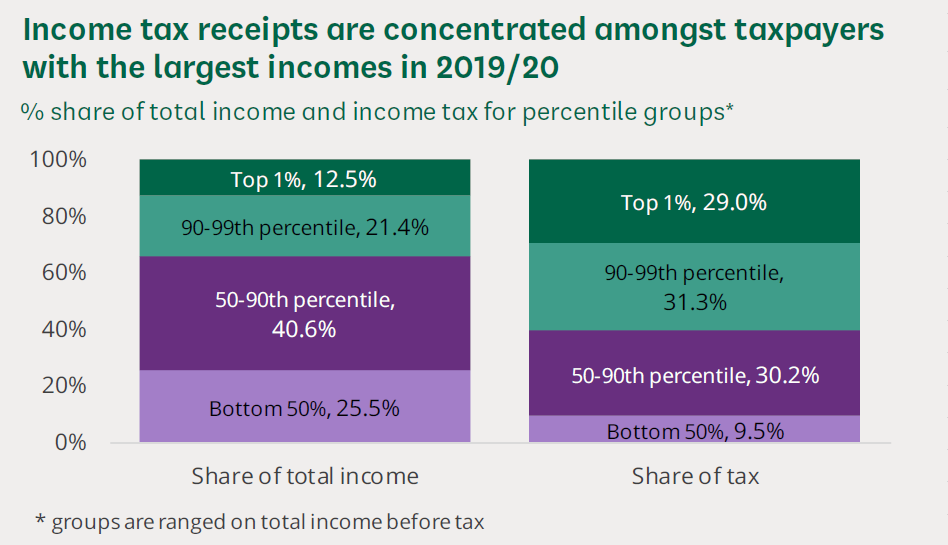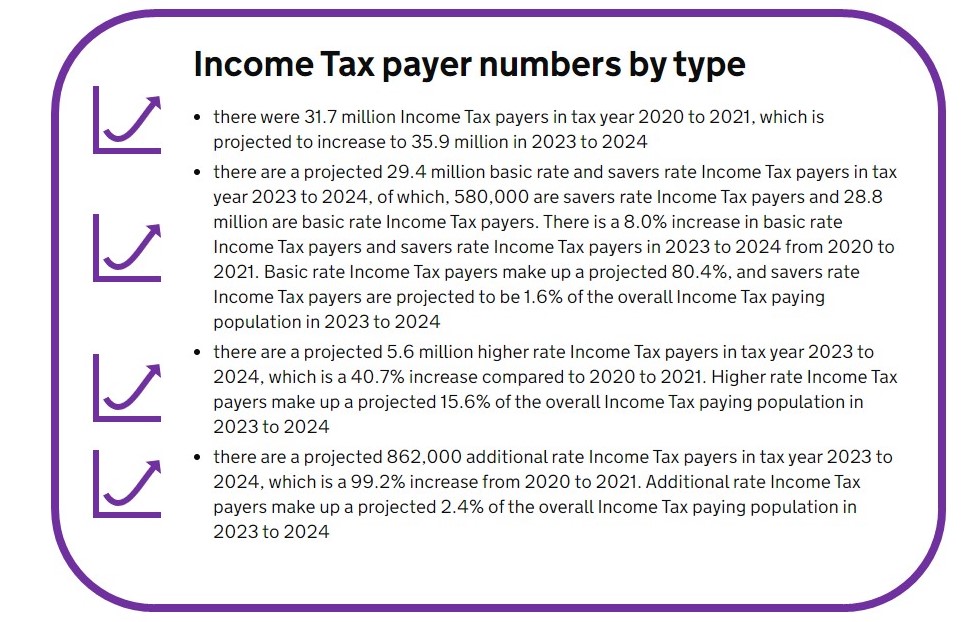Albert Einstein: “The hardest thing in the world to understand is the income tax.”
I have been trying to come up with a collective name for taxes. After all, we have a murder of crows, a crash of rhinos, a scurry of squirrels, and my personal favourite, a bloat of hippos. I’d like to propose we use a “stack of taxes”. Here’s why. There is an order to how allowances and taxes are levied. Simon’s tax tube presentation is a feast of financial facts and figures. It shows our taxes literally stacked one on top of another.
So, how are tax receipts spread across UK taxpayers? Government figures below highlights the Top 1%, who are those earning more than £180,000 a year. As you can see, their share of tax is growing. The infographic below is from the House of Commons Library tax statistics issue on 5th June 2023.
Much is written about avoiding taxes. In truth, there are perfectly legitimate government sanctioned ways of managing the level of tax you pay. Using your tax allowances to the full ensures you pay a “Goldilocks” level of tax. Not too much, not too little, just the right amount.
For UK tax, the 2021 Autumn budget froze personal allowances, basic, and higher rates of tax at £12,570, £37,700 and £150,000 respectively. In Scotland, the 2021/22 budget increased all the tax thresholds, except the top rate, by inflation. At the time we wrote highlighting the possible outcome. More people paying more tax, and not just on their income.
Recent government figures highlighted the number of people paying additional rate tax has reached its highest level ever at 862,000. Numbers were boosted by reducing the additional rate income tax band to £125,140 from £150,000. This coincides with a period of above average income growth of 7.3% March to May this year. UK average wage growth from 2001 until 2022 was 3.16% per year. A big win for the Treasury. By extending the period of frozen thresholds, the Treasury is expected to raise nearly £30bn extra in tax by 2028.
The following graphic uses data from HMRC National Statistics Summary published June 29th, 2023.
The 99.2% increase in the number of additional rate taxpayers since 2020/21 is staggering, but there’s more. Higher rate taxpayer numbers have increased by over 40%, with 29% more people entering this tax band since allowances were frozen.
Consultancy Lane Clark & Peacock (LCP) reported the increasing number of older people paying tax was driven by the relatively large (10.1%) increase in the state pension in April 2023, as well as inflation-linked increases to other pensions, at a time when the starting point for tax was once again frozen. Ex-pensions minister and LCP partner Steve Webb said, “The surge in the number of pensioners paying income tax shows that the policy of freezing tax thresholds is really beginning to bite.” Adding, “A combination of high inflation and frozen tax allowances means that well over 8 million people aged 65 or over are now paying tax, a doubling in the last two decades. The number of pensioners paying tax will continue to increase rapidly in years to come, particularly if inflation remains relatively high and thresholds continue to be frozen. The freezes also mean far more people now paying a top tax rate of 45% which was previously intended only for the very richest.”
We may be frustrated at the complexity and level of taxation in the UK, but countries that consistently appear at the top of global competitiveness and best places to live surveys have significantly higher levels of personal taxation. Scandinavia seems to dominate, especially Denmark, which always brings home the bacon in global economic and environmental surveys.
We take great care to help clients understand the impact of taxation in all its guises. If not fully understood, the effect on your pocket can be significant. But it doesn’t have to be. Tax can often appear complex and impenetrable, but that’s why we are here.
For those of you setting off on holiday, have a relaxing, less taxing time. You’ve earned it.


